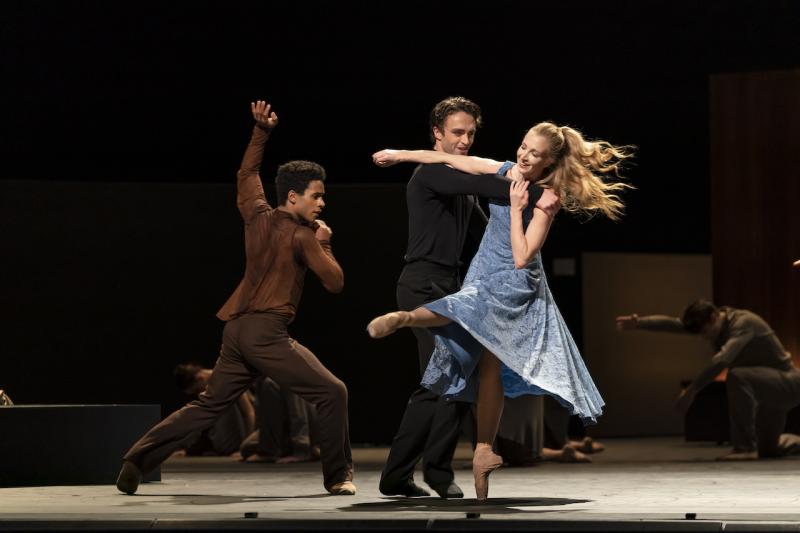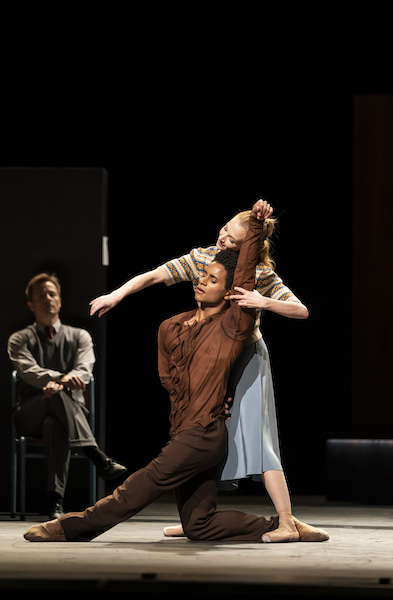The Cellist/Dances at a Gathering, Royal Ballet review - A grand love affair with a cello | reviews, news & interviews
The Cellist/Dances at a Gathering, Royal Ballet review - A grand love affair with a cello
The Cellist/Dances at a Gathering, Royal Ballet review - A grand love affair with a cello
The relationship between a great musician and her instrument, vividly imagined in dance

The cello is the stringed instrument most closely aligned to the human voice. It has a human shape, too, so in theory it was a short step for choreographer Cathy Marston to give it a living, breathing presence in her ballet about the legendary cellist Jacqueline du Pré. But what a giant leap of imagination that turned out to be.
Marston’s first work for the main stage of the Royal Opera House, The Cellist is no straightforward biography, still less does it touch on the torrid accusations that fuelled the film Hilary and Jackie, which was based on a book by her siblings and vehemently disputed by her friends. Instead it focuses on the grand love affair between a musician and her instrument, an affair begun in childhood and cruelly curtailed by multiple sclerosis when du Pré was 26.
 On a minimal set (by Hildegard Bechtler) whose sleek wooden curves suggest the instrument’s own, the dancer Marcelino Sambé (pictured right) becomes a vivid embodiment of du Pré’s cello. He is not merely an object to be carted along to auditions and concerts, but a personality who responds to attention, pines when ignored, and sometimes elevates his owner (literally) to a higher plane. If this sounds twee then it’s a credit to the choreographer’s skill and Sambé’s commitment that the dramatic result is emphatically not.
On a minimal set (by Hildegard Bechtler) whose sleek wooden curves suggest the instrument’s own, the dancer Marcelino Sambé (pictured right) becomes a vivid embodiment of du Pré’s cello. He is not merely an object to be carted along to auditions and concerts, but a personality who responds to attention, pines when ignored, and sometimes elevates his owner (literally) to a higher plane. If this sounds twee then it’s a credit to the choreographer’s skill and Sambé’s commitment that the dramatic result is emphatically not.
Our first sight of Sambé is almost foetal, curled around a cello case on the floor – an old soul awaiting his next incarnation. Child Jackie (Emma Lucano from the Royal Ballet School), at her first lesson, struggles to stretch her bowing arm around Sambé’s broad chest, or spread her small hands on the fingerboard presented by his arm. As her talent takes wing, the body language grows in dynamism, the teenage Jackie (Lauren Cuthbertson) swaying and leaning in, with Sambé luxuriating in her wildly joyous embrace. Philip Feeney’s score stylishly intersperses his own music with exerpts from du Pré’s repertoire – Fauré, Rachmaninov, and of course the Elgar concerto. We see the effect on her of her first encounter, then marriage, with the pianist Daniel Baremboim – Matthew Ball a darting, forceful presence, less forceful as Jackie’s illness starts to bite.
How to present such a hideous personal tragedy without mawkishness? The Cellist comes close but doesn’t cross the line. Marston limits the visible symptoms to a hand tremble and a short scene in which du Pré, believing herself to be in remission, attempts a public recital but cannot start the first bar. Typically, Marston deploys the corps de ballet in myriad ways, as a classful of children, audiences, clamouring record buyers, and memorably as a full orchestra in which each dancer is both player and instrument. Ultimately, the tone of The Cellist is celebratory, underlined by a closing image of Sambé slowly and dreamingly spinning like a vinyl LP.
Dances at a Gathering, first mounted on the Royal Ballet in 1970, the year after its creation, completes the programme. Five couples in turn inhabit an uninterrupted sequence of Chopin piano waltzes, mazurkas and études (performed here from the pit by Rob Clark). These are not your usual bonded ballet couples. They swap about, form threesomes, break off into solos. They behave, in fact, like any group of friends. There is no story, although there is a compulsion to look for one within its lilting blend of folk and classical steps rehearsed to look casual. When Alexander Campbell first appears, alone, for the opening number, a Mazurka, he stands motionless for the first bars gazing at the floor. When he does try a few steps, he merely marks them, before eventually the music siezes him and he’s off.
The genius of this work, and its novelty, lies in the way the choreographer gets under the skin of the dance impulse. Done well, it feels less like a performance than a contemplation. You could have heard an eyelash drop during the closing Nocturne. What happened to all those winter coughs?
rating
Explore topics
Share this article
The future of Arts Journalism
You can stop theartsdesk.com closing!
We urgently need financing to survive. Our fundraising drive has thus far raised £49,000 but we need to reach £100,000 or we will be forced to close. Please contribute here: https://gofund.me/c3f6033d
And if you can forward this information to anyone who might assist, we’d be grateful.

Subscribe to theartsdesk.com
Thank you for continuing to read our work on theartsdesk.com. For unlimited access to every article in its entirety, including our archive of more than 15,000 pieces, we're asking for £5 per month or £40 per year. We feel it's a very good deal, and hope you do too.
To take a subscription now simply click here.
And if you're looking for that extra gift for a friend or family member, why not treat them to a theartsdesk.com gift subscription?
more Dance
 'We are bowled over!' Thank you for your messages of love and support
Much-appreciated words of commendation from readers and the cultural community
'We are bowled over!' Thank you for your messages of love and support
Much-appreciated words of commendation from readers and the cultural community
 Like Water for Chocolate, Royal Ballet review - splendid dancing and sets, but there's too much plot
Christopher Wheeldon's version looks great but is too muddling to connect with fully
Like Water for Chocolate, Royal Ballet review - splendid dancing and sets, but there's too much plot
Christopher Wheeldon's version looks great but is too muddling to connect with fully
 iD-Reloaded, Cirque Éloize, Marlowe Theatre, Canterbury review - attitude, energy and invention
A riotous blend of urban dance music, hip hop and contemporary circus
iD-Reloaded, Cirque Éloize, Marlowe Theatre, Canterbury review - attitude, energy and invention
A riotous blend of urban dance music, hip hop and contemporary circus
 How to be a Dancer in 72,000 Easy Lessons, Teaċ Daṁsa review - a riveting account of a life in dance
Michael Keegan-Dolan's unique hybrid of physical theatre and comic monologue
How to be a Dancer in 72,000 Easy Lessons, Teaċ Daṁsa review - a riveting account of a life in dance
Michael Keegan-Dolan's unique hybrid of physical theatre and comic monologue
 A Single Man, Linbury Theatre review - an anatomy of melancholy, with breaks in the clouds
Ed Watson and Jonathan Goddard are extraordinary in Jonathan Watkins' dance theatre adaptation of Isherwood's novel
A Single Man, Linbury Theatre review - an anatomy of melancholy, with breaks in the clouds
Ed Watson and Jonathan Goddard are extraordinary in Jonathan Watkins' dance theatre adaptation of Isherwood's novel
 Peaky Blinders: The Redemption of Thomas Shelby, Rambert, Sadler's Wells review - exciting dancing, if you can see it
Six TV series reduced to 100 minutes' dance time doesn't quite compute
Peaky Blinders: The Redemption of Thomas Shelby, Rambert, Sadler's Wells review - exciting dancing, if you can see it
Six TV series reduced to 100 minutes' dance time doesn't quite compute
 Giselle, National Ballet of Japan review - return of a classic, refreshed and impeccably danced
First visit by Miyako Yoshida's company leaves you wanting more
Giselle, National Ballet of Japan review - return of a classic, refreshed and impeccably danced
First visit by Miyako Yoshida's company leaves you wanting more
 Quadrophenia, Sadler's Wells review - missed opportunity to give new stage life to a Who classic
The brilliant cast need a tighter score and a stronger narrative
Quadrophenia, Sadler's Wells review - missed opportunity to give new stage life to a Who classic
The brilliant cast need a tighter score and a stronger narrative
 The Midnight Bell, Sadler's Wells review - a first reprise for one of Matthew Bourne's most compelling shows to date
The after-hours lives of the sad and lonely are drawn with compassion, originality and skill
The Midnight Bell, Sadler's Wells review - a first reprise for one of Matthew Bourne's most compelling shows to date
The after-hours lives of the sad and lonely are drawn with compassion, originality and skill
 Ballet to Broadway: Wheeldon Works, Royal Ballet review - the impressive range and reach of Christopher Wheeldon's craft
The title says it: as dancemaker, as creative magnet, the man clearly works his socks off
Ballet to Broadway: Wheeldon Works, Royal Ballet review - the impressive range and reach of Christopher Wheeldon's craft
The title says it: as dancemaker, as creative magnet, the man clearly works his socks off
 The Forsythe Programme, English National Ballet review - brains, beauty and bravura
Once again the veteran choreographer and maverick William Forsythe raises ENB's game
The Forsythe Programme, English National Ballet review - brains, beauty and bravura
Once again the veteran choreographer and maverick William Forsythe raises ENB's game
 Sad Book, Hackney Empire review - What we feel, what we show, and the many ways we deal with sadness
A book about navigating grief feeds into unusual and compelling dance theatre
Sad Book, Hackney Empire review - What we feel, what we show, and the many ways we deal with sadness
A book about navigating grief feeds into unusual and compelling dance theatre

Add comment